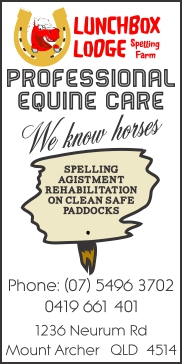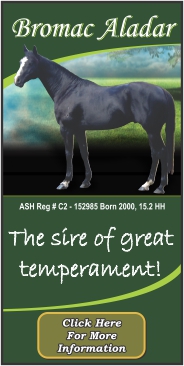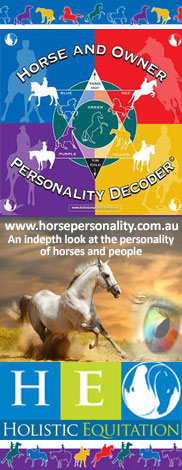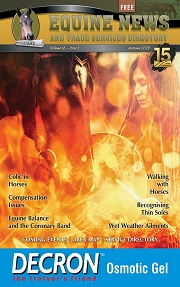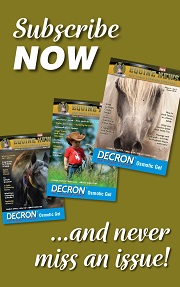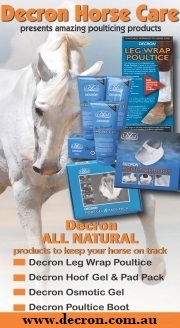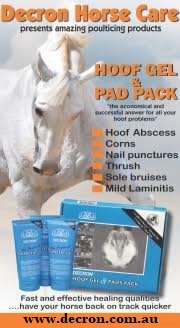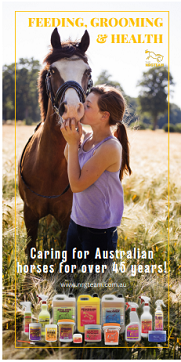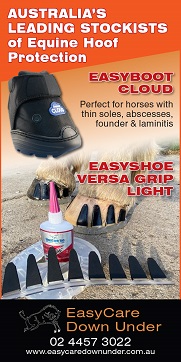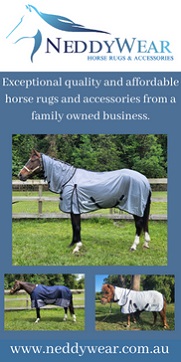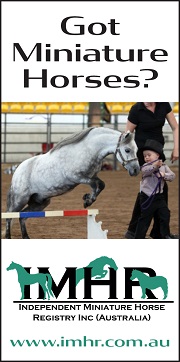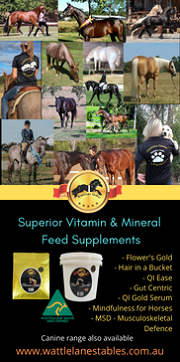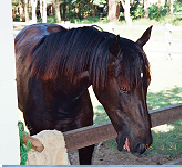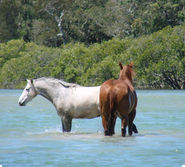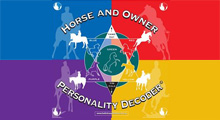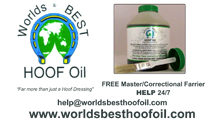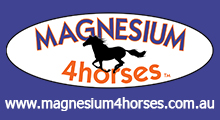By Dr. J H Stewart

A widely-used and popular phrase is that ‘feeding horses is both an art and a science’. The science underpins the formulation of a ration and the art is adjusting this ration to best fit the circumstances of an individual horse. There is not one correct way to feed any horse. This allows flexibility to adjust the ration for an individual horse – but it also allows the development of controversies, myths and feeding traditions that are based on little or no objective evidence.
There are lots of discussions and concerns around feeding soy to horses – probably more so than any other feedstuff!
After water, the first and foremost nutrient required is protein. Proteins are the only foods which can make body tissue. Proteins are long chains of amino acids – the ‘building blocks’ of all life and necessary for growth, development, reproduction, and healthy tissues. Amino acids are of two basic types – essential and nonessential. Essential amino acids are those that the body cannot make and which must be provided by the diet. These include: arginine, histidine, isoleucine, leucine, methionine, cystine, phenylalanine, tyrosine, threonine, tryptophan and valine. Other amino acids are called ‘conditionally essential’ because demands can exceed the body’s ability to make them.
If a feed provides an adequate amount of essential amino acids for maintenance and growth, it is referred to as containing high-quality protein. On the other hand, if the food does not supply the horse with recommended essential amino acids, it is called low-quality protein. The % protein is not related to the quality of the protein. A feed may contain 20% protein – but if it doesn’t have any essential amino acids, it may be only 5% useable. The amount of protein in the diet that the body can use is related to the proteins lysine content. If the lysine content is low, all other proteins in the diet will be unusable and wasted (Figure 1).
If a feed or protein supplement has lots of nonessential amino acids ie unusable protein it just becomes extra protein that the body will have to convert to urea/ammonia.
Soymeal contains the highest quality protein and the highest amount of lysine of the plant-based protein supplements. For example soymeal is 44% protein, lupins 35% and sugar beet 8.6%. But it’s the amino acids that count because deficiency of any single one will place a limit on tissue repair and building.
It’s helpful to think of tissue building as similar to making a cake! Each tissue, like each cake has it’s own recipe. If you’re making a chocolate cake (the best sort of cake!) and you run out of cocoa, it doesn’t matter how much butter, sugar, eggs etc you have, you can’t make a chocolate cake. In horses, lysine, methionine and threonine are widely used in ‘recipes’ for cell repair and building. If the diet doesn’t provide enough of these ingredients, cell repair and production stops.
Or if you prefer wine, the shortest plank in the wine barrel sets a limit to how much wine the barrel has. Similarly, a deficiency of an essential amino acid places a limit on how much protein the body can build.

Soymeal provides nearly 34grams of lysine, around 7g methionine and 19g of threonine per kg, lupins 16g of lysine, 3g of methionine and 13g of threonine per kg, while sugar beet provides approximately 4-5g lysine, 0.8g of methionine and 4g of threonine per kg.
Protein for growth: Lysine is required in greater amounts in growing horses. Without adequate lysine, foals will have a decreased growth rate because the tissues will not have the amino acids necessary for growth. Protein is also necessary for maintenance of body tissues, lactation and exercise capacity and performance. Although the horse is not working, growing or producing milk, protein is still needed for maintenance of body tissues and cells – regrowth of skin cells, hair and tissue cell maintenance. Without adequate protein intake, hair will begin to look dull and there is potential for weight loss.
Protein for repair: Soybean meal is high in essential amino acids which is really important to heal the damaged hooves in horses that have had laminitis. Using soybean meal as the primary protein source in a diet and adding lysine and methionine makes most diets as correct as possible. For horses with laminitis, soymeal delivers again. Starch and sugar from any source can be dangerous for horses at risk or with clinical and subclinical laminitis. Feeds with less than 15% sugar and starch are indicated. Soybean meal contains approximately 12% sugar + starch and has a low glycaemic index.
But soymeal also contains many other beneficial bioactive compounds shown to reduce insulin-resistance and support the beneficial gut bacteria and suppress growth of pathogenic bacteria in humans and other animals. In addition to lots of good anti-oxidants, soymeal contains isoflavones, quecertins and galactooligosaccharides (one of the most potent prebiotics) that improve insulin sensitivity.
There has been some research that demonstrates a potential negative effect of soy on insulin responses and plasma adiponectin and some have extrapolated this to horses. However, the relevance to equine laminitis/insulin resistance/EMS is questionable as the work was done in male monkeys https://www.ncbi.nlm.nih.gov/pmc/articles/PMC2570347/pdf/nihms57023.pdf
SOY HULLS
Soy hulls are high in pectin and other soluble fibres. Because they are digested mostly in the caecum and contain relatively small amounts of starch, their use in horse diets does not pose a high risk for colic and laminitis. Soybean hulls are more completely and rapidly fermented by the caecal microflora than is hay and are categorised as ‘super fibres’. Super fibres provide slightly less energy than oats and barley – but more energy than other forages/roughage.
Soybean hulls appear to stimulate caecal fermentation and to be a suitable replacement for hay in equine diets. This may be an especially important finding for owners of geriatric horses that often have difficulty consuming roughages.
Soyhulls are another option to provide fibre during times of scarcity and drought or when hay is unavailable. As always, to avoid digestive upset, any change to a horse’s diet should be made slowly over a period of several days. The recommended method of introducing a new dietary component is to include a small amount in the first feeding and continue to increase the proportion of new feed to old feed for four or five days until the desired amount is being fed.
Soyhulls appear to be an acceptable replacement for 25-50% of the total forage in diets for horses. Soybean hulls appear to stimulate caecal fermentation and are a suitable replacement for hay. They are also more digestible than traditional fibre sources. For instance, hay is 40-60% digestible, depending on its quality, and soy hulls are 80% and 75% digestible.
Multiple uses for soy hulls:
• Horses with dental problems often can’t eat enough hay to meet their fibre requirements. Soyhulls can help.
• Horses on high grain intakes may have a reduced hay intake – super fibres are ideal.
• Horses that have difficulty maintaining weight.
• Horses working at moderate speeds over long distances, such as endurance horses benefit from good gut health. Super fibres can increase water intake.
• Super fibres can support energy requirements for horses that need low starch feeds eg PSSM and recurrent exertional rhabdomyolysis (RER)
Raw whole soybeans are not recommended because they contain substances that decrease growth rate. Heat processing destroys these growth inhibitors. Soybean meal has been chosen as the main source of protein in horse feeds for decades and has proven to be safe for many horses. Soy hulls may contain traces of the growth inhibitors and its worth checking with the manufacturer.
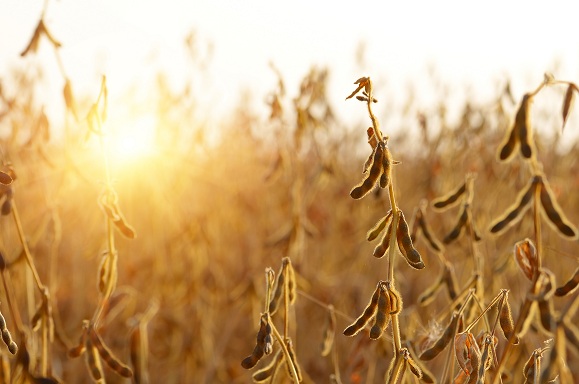
All content provided in this editorial is for general use and information only and does not constitute advice or a veterinary opinion. It is not intended as specific medical advice or opinion and should not be relied on in place of consultation with your equine veterinarian
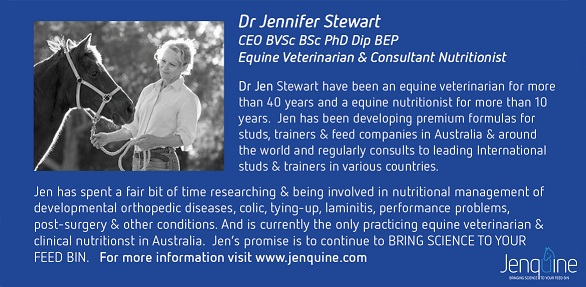
Website: www.jenquine.com









